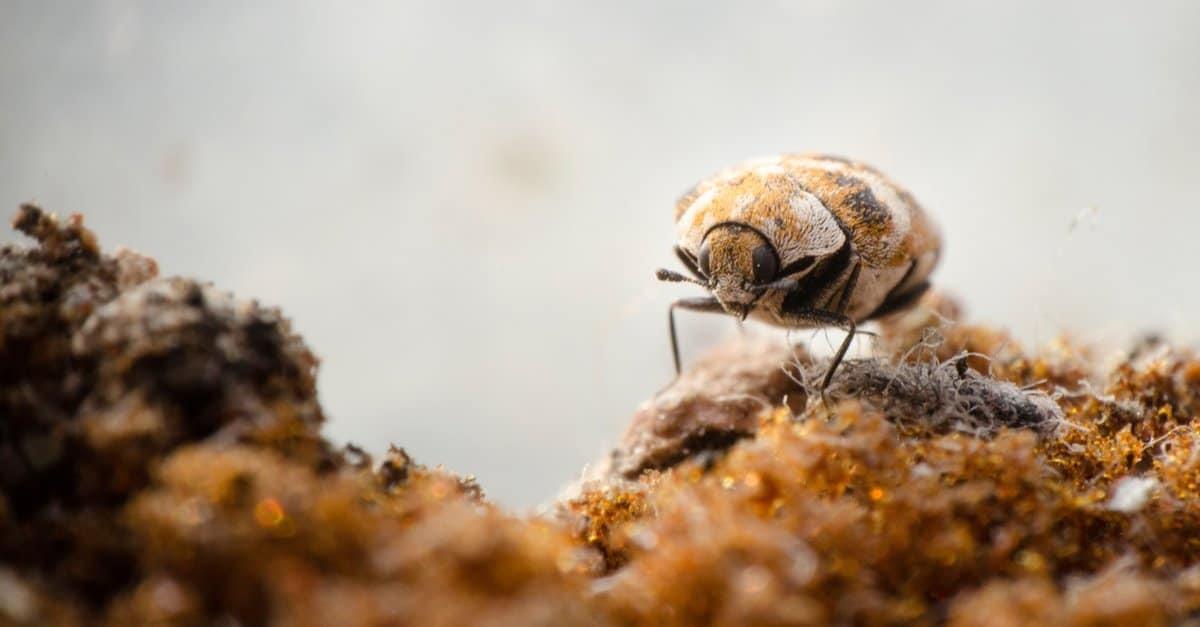Identifying and Controlling Carpet Beetles: Protecting Your Belongings
Introduction
Carpet beetles may be small in size, but they can wreak havoc on your belongings if left unchecked. These tiny insects can infest your home and cause significant damage to carpets, clothing, and other fabrics. In Singapore, where the warm and humid climate provides an ideal environment for carpet beetles to thrive, it’s essential to be proactive in identifying and controlling these pests to protect your cherished belongings. In this comprehensive guide, we will explore the world of carpet beetles, from identification to prevention and control measures, all designed to help you safeguard your possessions.
Getting to Know Carpet Beetles
Carpet beetles (scientifically known as Anthrenus verbasci and Anthrenus scrophulariae) are small, oval-shaped insects that belong to the family Dermestidae. They measure around 1/16 to 1/8 inches in length and have a distinctive appearance, often covered in tiny scales or hairs. These scales give them a somewhat mottled or speckled appearance.
Identifying Carpet Beetles
Carpet beetles go through a four-stage life cycle: egg, larva, pupa, and adult. It’s the larval stage that causes the most damage to your belongings. Identifying carpet beetle larvae is essential for effective control. Here are some key characteristics to look for:
- Color: Larvae can range in color from light brown to dark brown, often with a striped or banded pattern.
- Shape: They have a tapered, elongated shape and are covered in fine hairs.
- Size: Depending on their age, carpet beetle larvae can measure from 1/8 inch to 1/4 inch.
- Movement: They are active and move relatively quickly, making them easier to spot.
Carpet beetles in Singapore are commonly found in a variety of indoor environments, including homes, museums, and commercial buildings. They are drawn to areas with a food source, such as:
- Carpets and Rugs: These provide an ideal hiding place and food source for carpet beetle larvae.
- Upholstered Furniture: Especially if made from natural fibers.
- Clothing: Wool, silk, and other natural fabrics are particularly attractive to them.
- Animal Products: Carpets made from animal hides, feathers, or fur can be infested.
- Stored Food: In some cases, they may infest stored food products.
The Damage Caused by Carpet Beetles
Understanding the potential harm carpet beetles can cause is crucial in motivating you to take action. These seemingly innocuous insects can wreak havoc on your belongings in several ways:
Fabric Damage
Carpet beetle larvae feed on natural fibers, such as wool, silk, and cotton. They can chew through these materials, creating irregular holes and causing significant damage to clothing, rugs, and upholstery. This damage can be costly to repair or replace.
Shedding Hairs and Scales
Carpet beetle larvae have a unique defense mechanism. They shed tiny hairs and scales that can cause allergic reactions in some individuals. These hairs and scales can become airborne and be inhaled, potentially leading to skin irritation, respiratory issues, or even allergic dermatitis.
Contamination of Stored Food
In some cases, carpet beetles can infest stored food products, contaminating them with their presence and fecal matter. This can render food items inedible and lead to foodborne illnesses.
Prevention and Early Detection
Preventing a carpet beetle infestation is the best way to protect your belongings. Here are some effective prevention and early detection strategies:
Maintain Cleanliness
Regularly vacuum your home, paying close attention to areas where carpet beetles are likely to hide, such as carpets, rugs, and upholstered furniture. Be sure to empty the vacuum cleaner bag or canister outside to prevent any trapped beetles from re-infesting your home.
Store Clothing Properly
Store clothing and fabrics in airtight containers or vacuum-sealed bags to prevent carpet beetles from accessing them. Ensure that the storage area is clean and dry, as carpet beetles are attracted to damp environments.
Inspect Second Hand Items
Be cautious when bringing secondhand furniture, clothing, or rugs into your home. Thoroughly inspect these items for signs of infestation before introducing them to your living space.
Seal Cracks and Crevices
Seal any cracks or crevices in your home’s exterior to prevent carpet beetles from entering. Check for gaps around windows, doors, and vents.
Identifying an Infestation
Early detection is key to preventing a minor carpet beetle problem from becoming a major infestation. Here are some signs that you may have a carpet beetle infestation:
Visible Adult Beetles
Seeing adult carpet beetles flying around your home is a clear sign of an infestation. These beetles are often attracted to light sources.
Larval Casings
Look for shed larval skins or casings near infested areas. These casings can be a telltale sign that larvae are present.
Damage to Fabrics
Inspect your clothing, rugs, and upholstery for signs of damage, such as irregular holes or chewed edges.
Presence of Larvae
Carefully examine areas where you suspect an infestation. You may spot carpet beetle larvae crawling on fabrics or surfaces.
Controlling Carpet Beetle Infestations
If you suspect or confirm a carpet beetle infestation, it’s essential to take immediate action to prevent further damage. Here’s a step-by-step guide on how to control carpet beetle infestations effectively:
Isolate and Remove Infested Items
Identify and isolate infested items. Remove them from the affected area to prevent the infestation from spreading.
Thorough Cleaning
Vacuum the entire affected area, paying special attention to carpets, rugs, and upholstered furniture. Be sure to discard the vacuum bag or clean the canister after use. Steam cleaning can also be an effective method for killing carpet beetle larvae.
Wash and Dry Affected Fabrics
Wash infested clothing, linens, and curtains in hot water and dry them at a high temperature. This will kill any remaining larvae and eggs.
Use Insecticides
Consider using insecticides specifically designed for carpet beetles. Follow the manufacturer’s instructions carefully, and use caution when applying chemicals in your home.
Professional Pest Control
For severe infestations or if your efforts do not yield results, it’s advisable to seek the help of a professional pest control service in Singapore. They have the expertise and tools to effectively eliminate carpet beetles from your home.
Maintaining a Carpet Beetle-Free Home
Once you’ve successfully eradicated a carpet beetle infestation, it’s important to take steps to prevent future occurrences:
Continue Cleaning Routines
Maintain regular cleaning routines, including vacuuming, dusting, and washing fabrics. By keeping your home clean and free of debris, you can make it less attractive to carpet beetles.
Store Belongings Properly
Continue to store clothing and fabrics in airtight containers to prevent re-infestation. Regularly inspect stored items for any signs of carpet beetles.
Seal Entry Points
Keep an eye out for any potential entry points in your home and seal them promptly to prevent carpet beetles from gaining access.
Outdoor Maintenance
Maintain your outdoor environment by keeping your lawn well-manicured and eliminating any debris or vegetation near your home’s foundation that may attract carpet beetles.
Conclusion: Protecting Your Belongings from Carpet Beetles
Carpet beetles may be small, but the damage they can cause to your belongings is far from insignificant. To protect your cherished possessions and maintain a pest-free home in Singapore, it’s essential to understand the habits and characteristics of carpet beetles, be vigilant in preventing infestations, and take immediate action if an infestation is detected. By following the guidelines outlined in this comprehensive guide, you can ensure that your home remains a safe and beetle-free environment for your belongings.
Frequently Asked Questions (FAQs)
How to identify carpet beetles?
Carpet beetles are small, oval-shaped insects that are typically 1/8 to 1/4 inch long. They have a variety of colors, including black, brown, and white. Carpet beetles have visible antennae and six legs. One of the most common signs of a carpet beetle infestation is the presence of shed carpet beetle skins. These skins are small, brown, and resemble tiny grains of rice.
What damage do carpet beetles cause?
Carpet beetle larvae feed on natural fibers, such as wool, silk, and feathers. This can damage carpets, clothing, furniture, and other household items. Carpet beetles can also contaminate food with their shed skins and frass (insect droppings).
How to prevent carpet beetles?
There are a number of things you can do to prevent carpet beetle infestations. Regularly vacuum carpets, rugs, and upholstery. Pay close attention to areas where carpet beetles are likely to hide, such as along baseboards, around furniture, and in closets. Store clothing in airtight containers. Wash clothes in hot water (at least 140 degrees Fahrenheit) to kill any carpet beetles that may be present. Avoid bringing secondhand clothing or furniture into your home, as these items may be harboring carpet beetles.
How to detect a carpet beetle infestation?
There are a number of signs that may indicate a carpet beetle infestation. These include the presence of adult carpet beetles, carpet beetle larvae, or shed carpet beetle skins. You may also see damaged carpets, clothing, or furniture.
How to control carpet beetles?
If you suspect a carpet beetle infestation, it is important to take action to control the problem. There are a number of insecticides that are effective against carpet beetles. However, it is important to read and follow the label instructions carefully before using any insecticide. You may also want to consider hiring a professional pest control company to treat your home for carpet beetles.



